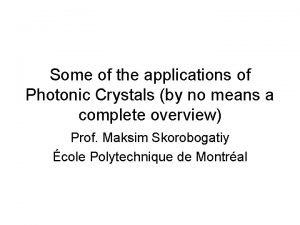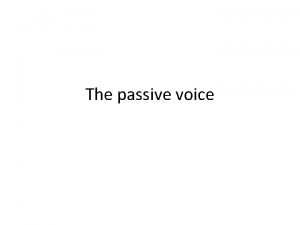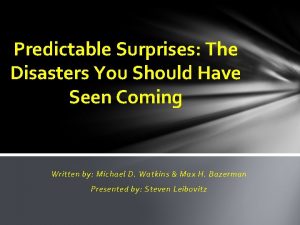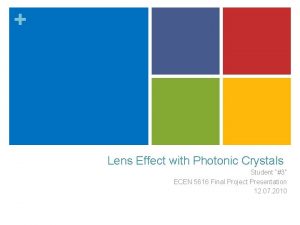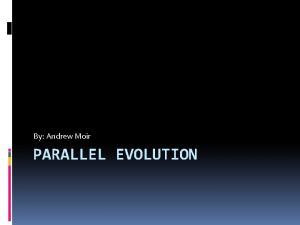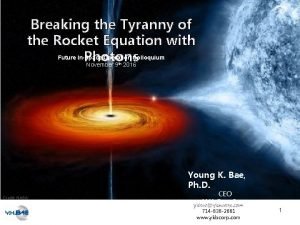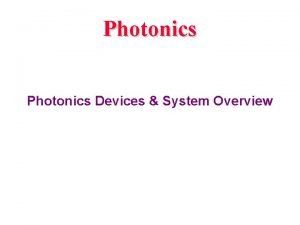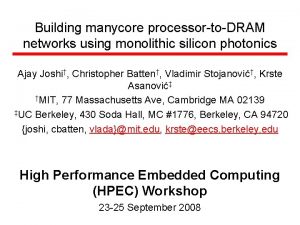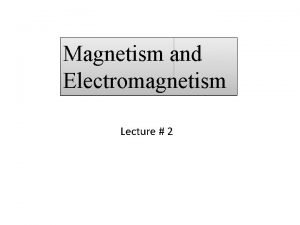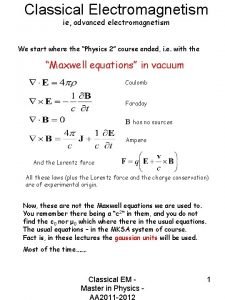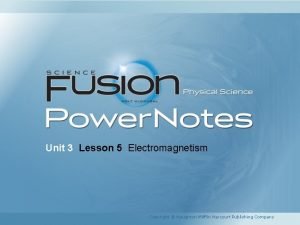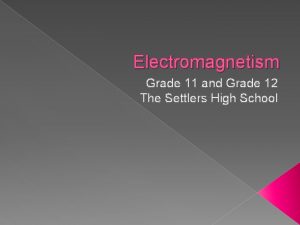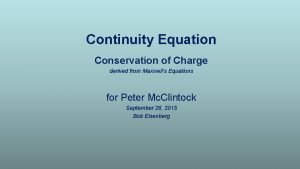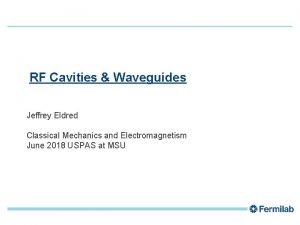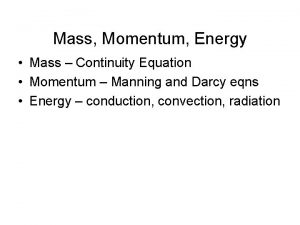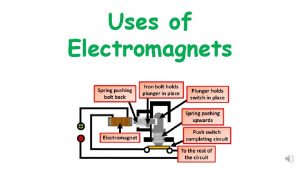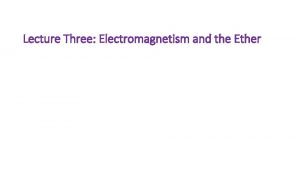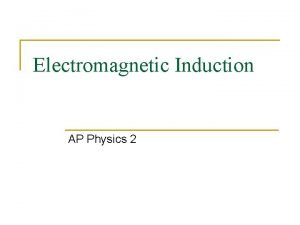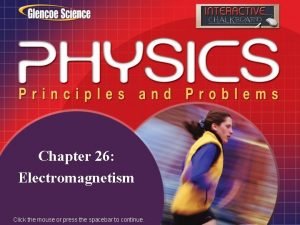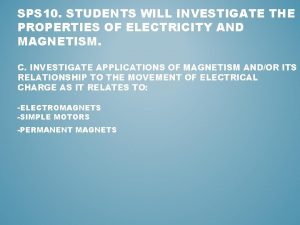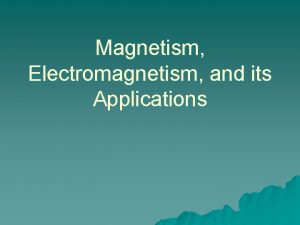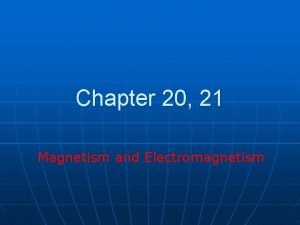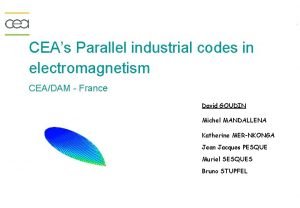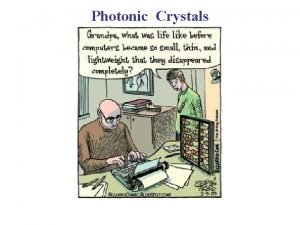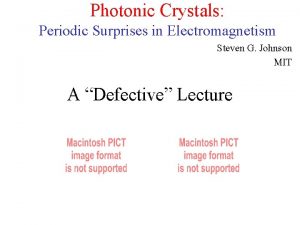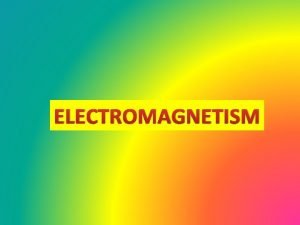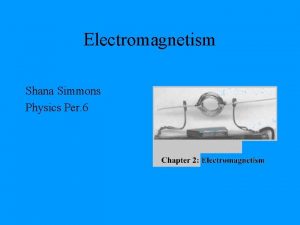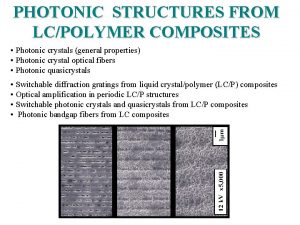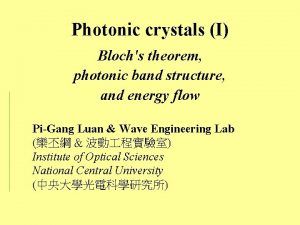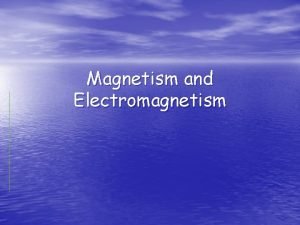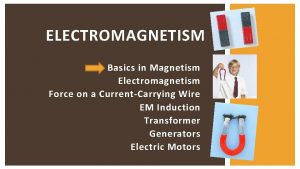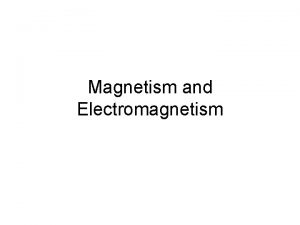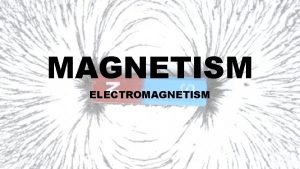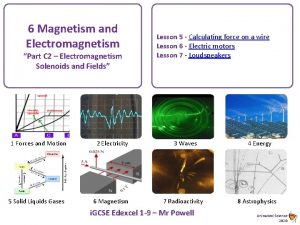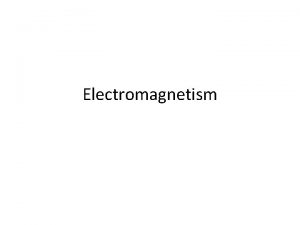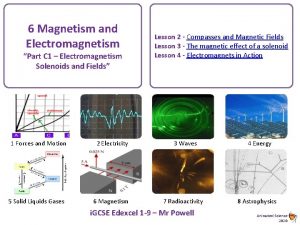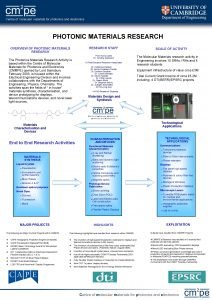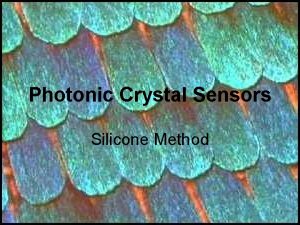Photonic Crystals Periodic Surprises in Electromagnetism Steven G





























- Slides: 29

Photonic Crystals: Periodic Surprises in Electromagnetism Steven G. Johnson MIT

To Begin: A Cartoon in 2 d scattering planewave

To Begin: A Cartoon in 2 d a • • • • • • • • • • • • • • • • • • planewave for most l, beam(s) propagate through crystal without scattering (scattering cancels coherently). . . but for some l (~ 2 a), no light can propagate: a photonic band gap

Photonic Crystals periodic electromagnetic media 1887 1987 with photonic band gaps: “optical insulators” (need a more complex topology)

Photonic Crystals periodic electromagnetic media can trap light in cavities and waveguides (“wires”) magical oven mitts for holding and controlling light with photonic band gaps: “optical insulators”

Photonic Crystals periodic electromagnetic media But how can we understand such complex systems? Add up the infinite sum of scattering? Ugh!

A mystery from the 19 th century conductive material + + e– + + current: conductivity (measured) mean free path (distance) of electrons

A mystery from the 19 th century crystalline conductor (e. g. copper) + + + + e– e– + + + + 10’s + of + periods! + + + + current: conductivity (measured) mean free path (distance) of electrons

A mystery solved… 1 electrons are waves (quantum mechanics) waves in a periodic medium can propagate 2 without scattering: Bloch’s Theorem (1 d: Floquet’s) The foundations do not depend on the specific wave equation.

Time to Analyze the Cartoon a • • • • • • • • • • • • • • • • • • planewave for most l, beam(s) propagate through crystal without scattering (scattering cancels coherently). . . but for some l (~ 2 a), no light can propagate: a photonic band gap

Fun with Math First task: 0 get rid of this mess dielectric function e(x) = n 2(x) + constraint eigen-operator eigen-value eigen-state

Hermitian Eigenproblems + constraint eigen-operator eigen-value eigen-state Hermitian for real (lossless) e well-known properties from linear algebra: w are real (lossless) eigen-states are orthogonal eigen-states are complete (give all solutions)

Periodic Hermitian Eigenproblems [ G. Floquet, “Sur les équations différentielles linéaries à coefficients périodiques, ” Ann. École Norm. Sup. 12, 47– 88 (1883). ] [ F. Bloch, “Über die quantenmechanik der electronen in kristallgittern, ” Z. Physik 52, 555– 600 (1928). ] if eigen-operator is periodic, then Bloch-Floquet theorem applies: can choose: planewave periodic “envelope” Corollary 1: k is conserved, i. e. no scattering of Bloch wave Corollary 2: given by finite unit cell, so w are discrete wn(k)

Periodic Hermitian Eigenproblems Corollary 2: given by finite unit cell, so w are discrete wn(k) band diagram (dispersion relation) w 3 w map of what states exist & can interact w 2 w 1 k ? range of k?

Periodic Hermitian Eigenproblems in 1 d e 1 e 2 e 1 e 2 a e(x) = e(x+a) Consider k+2π/a: k is periodic: k + 2π/a equivalent to k “quasi-phase-matching” periodic! satisfies same equation as Hk = Hk

Periodic Hermitian Eigenproblems in 1 d e 1 e 2 e 1 e 2 k is periodic: k + 2π/a equivalent to k “quasi-phase-matching” a e(x) = e(x+a) w band gap –π/a 0 π/a irreducible Brillouin zone k

Any 1 d Periodic System has a Gap [ Lord Rayleigh, “On the maintenance of vibrations by forces of double frequency, and on the propagation of waves through a medium endowed with a periodic structure, ” Philosophical Magazine 24, 145– 159 (1887). ] Start with a uniform (1 d) medium: e 1 w 0 k

Any 1 d Periodic System has a Gap [ Lord Rayleigh, “On the maintenance of vibrations by forces of double frequency, and on the propagation of waves through a medium endowed with a periodic structure, ” Philosophical Magazine 24, 145– 159 (1887). ] Treat it as “artificially” periodic bands are “folded” by 2π/a equivalence –π/a e 1 a e(x) = e(x+a) w 0 π/a k

Any 1 d Periodic System has a Gap [ Lord Rayleigh, “On the maintenance of vibrations by forces of double frequency, and on the propagation of waves through a medium endowed with a periodic structure, ” Philosophical Magazine 24, 145– 159 (1887). ] Treat it as “artificially” periodic a e 1 w 0 π/a x=0 e(x) = e(x+a)

Any 1 d Periodic System has a Gap [ Lord Rayleigh, “On the maintenance of vibrations by forces of double frequency, and on the propagation of waves through a medium endowed with a periodic structure, ” Philosophical Magazine 24, 145– 159 (1887). ] Add a small “real” periodicity e 2 = e 1 + De e(x) = e(x+a) e 1 e 2 e 1 e 2 w 0 a π/a x=0

Any 1 d Periodic System has a Gap [ Lord Rayleigh, “On the maintenance of vibrations by forces of double frequency, and on the propagation of waves through a medium endowed with a periodic structure, ” Philosophical Magazine 24, 145– 159 (1887). ] Add a small “real” periodicity e 2 = e 1 + De Splitting of degeneracy: state concentrated in higher index (e 2) has lower frequency a e 1 e 2 e 1 e 2 w band gap 0 e(x) = e(x+a) π/a x=0

Some 2 d and 3 d systems have gaps • In general, eigen-frequencies satisfy Variational Theorem: “kinetic” inverse “potential” bands “want” to be in high-e …but are forced out by orthogonality –> band gap (maybe)

algebraic interlude completed… … I hope you were taking notes* [ *if not, see e. g. : Joannopoulos, Meade, and Winn, Photonic Crystals: Molding the Flow of Light ]

2 d periodicity, e=12: 1 frequency w (2πc/a) = a /l a irreducible Brillouin zone M G X G TM X E H M G gap for n > ~1. 75: 1

2 d periodicity, e=12: 1 Ez (+ 90° rotated version) Ez G – + TM X E H M G gap for n > ~1. 75: 1

2 d periodicity, e=12: 1 frequency w (2πc/a) = a /l a irreducible Brillouin zone M G X G TM X E H G M E TE H

2 d photonic crystal: TE gap, e=12: 1 TE bands TM bands E TE H gap for n > ~1. 4: 1

3 d photonic crystal: complete gap , e=12: 1 I. II. gap for n > ~4: 1 [ S. G. Johnson et al. , Appl. Phys. Lett. 77, 3490 (2000) ]

You, too, can compute photonic eigenmodes! MIT Photonic-Bands (MPB) package: http: //ab-initio. mit. edu/mpb on Athena: add mpb
 Applications of photonic crystals
Applications of photonic crystals Eats present simple
Eats present simple Predictable surprises examples
Predictable surprises examples Photonic medicine
Photonic medicine Photonic
Photonic Andy moir photonic
Andy moir photonic Tyranny of the rocket equation
Tyranny of the rocket equation Photonic devices
Photonic devices Photonic chip paperclip
Photonic chip paperclip Andy moir photonic
Andy moir photonic Relative permeability of magnetic material
Relative permeability of magnetic material Electromagnetism khan academy
Electromagnetism khan academy Electromagnetism
Electromagnetism Lesson 5 electromagnetism answer key
Lesson 5 electromagnetism answer key What is displacement current
What is displacement current Magnetic field lines of a bar magnet
Magnetic field lines of a bar magnet Grade 11 electromagnetism
Grade 11 electromagnetism Continuity equation electromagnetism
Continuity equation electromagnetism Electromagnetism
Electromagnetism Continuity equation
Continuity equation Electromagnetism uses
Electromagnetism uses Oerstad
Oerstad Electromagnetism
Electromagnetism Magnetic force unit
Magnetic force unit Flux linkage unit
Flux linkage unit Chapter 26 electromagnetism study guide answers
Chapter 26 electromagnetism study guide answers Electromagnetism
Electromagnetism Magnetism and electromagnetism
Magnetism and electromagnetism Methernitha testatika
Methernitha testatika Electromagnetism
Electromagnetism
